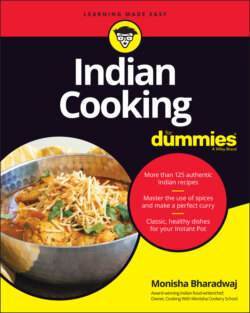Читать книгу Indian Cooking For Dummies - Monisha Bharadwaj - Страница 37
Putting Together Vegetarian and Vegan Meals
ОглавлениеIf you’ve just embarked on a vegetarian or vegan lifestyle, or even if you’re just cutting down on your meat consumption, Indian food has lots to offer. You’ll want to think not only about stripping your current diet of animal products but also about how to build a sustainable, balanced way of vegetarian or vegan eating that keeps you satisfied and healthy.
Indian meals are a balance of carbohydrates, proteins, fat, and fiber that comes from beans, legumes, and vegetables. There are plenty of options to choose from when planning your vegetarian menu. Leaving out dairy products (such as ghee, yogurt, and milk) and other animal products (like honey) can make it vegan, too. In India, eggs are considered nonvegetarian.
Here are some tips for putting together a vegetarian or vegan meal:
Think of your daily nutritional requirements. It’s all too easy to pick carbohydrates such as rice and bread and add vegetables to make up a vegetarian meal, but you’ll want to be adding those proteins, too. Getting a balance of nutrients will make it a healthy meal. Here’s how to get enough fat and protein in your vegetarian or vegan diet:Eat more beans and legumes. Introducing beans and legumes into your diet is easy with Indian recipes. Red kidney beans, mung beans, split peas, chickpeas, red lentils, brown lentils, and more are delicious in curries and stir-fries. They pair beautifully with spices and are hearty, too.Combine legumes and grains. Food professionals have recognized for a long time now that combining legumes (such as lentils) and grains (such as rice) yields a complete protein. It’s hardly surprising that in a vegetarian-inclined country like India, the staple meal is rice and dal.Swap meat and poultry with textured vegetable protein. Textured vegetable protein has been used in Indian vegetarian meals for decades. It’s meaty in texture and absorbs flavors of spices easily, transforming it from a rather tasteless ingredient to a delicious one.Add nuts and seeds to your meals. Many Indian curries have a blended spiced sauce that the main ingredient is cooked in. This base is often thickened with nuts such as cashews, peanuts, and almonds. They also boost the protein and good fat content of the recipe. Also, try sprinkling nuts and seeds over your rice and salads.Include dairy in your meal (if you’re not vegan). Most Indian meals are served with yogurt in some form — either plain or as a raita with vegetables in it. Paneer or Indian cottage cheese is another option, and you’ll get some good fats with your dairy, too!Choose the right vegetables. Avocados are known for their good fats and other wonderful nutrients. Mushrooms and broccoli have not only fiber but also protein.Drizzle over some ghee or coconut oil. Both ghee (clarified butter) and coconut oil have been used in Indian cooking for centuries. Drizzling a spoon of either over your rice or curry (instead of cooking your entire meal in it) means you can keep track of how much you’re eating while adding good fats to your diet.
Keep it varied. Many years ago, being vegetarian often meant eating cheese and potatoes every day, but this is no longer the case. The huge variety of ingredients and recipes in Indian cooking means that having a different dinner every night of the year is very possible. Just look at the list of lentils in Chapter 4!
Make a simple meal plan for a few days at a time. This plan will help you create a menu that is varied and brings in the nutrition you need, too. When you start to cook your meal for the day, instead of cobbling together something easy in a hurry, you’ll have control over what you eat. You’ll also be able to make the most of your ingredients so there’s less food waste. Over the week, a bag of carrots could be used up for a crunchy salad, a vegetable and lentil dal, and a spiced carrot stir-fry.
Stop thinking of a meal as a main with side dishes. In an Indian meal, everything is served together and is considered a “main.” In the meat-based Western diet, people are encouraged to think of the meat as the main dish. Start thinking of your meal in terms of components rather than just one dish that everything else is built around.
Learn about your nutritional needs at different times of the day. A protein-packed power breakfast will mean less snacking until lunchtime. Add nuts and seeds, nut butters, and milks to stay satiated. Lunch often needs to be quick, so choosing whole carbohydrates, proteins, and unsaturated fats along with fresh vegetables (brown rice with beans or a vegetable dal with an avocado salad) will help you beat that dreaded midafternoon slump.
Have plenty of ingredients to choose from in your fridge and cupboard. A well-stocked pantry is the vegetarian or vegan chef’s joy. If you have cans of beans, bags of dried lentils, rice, flours, spices, and a fridge drawer of colorful vegetables, you can create a vast variety of delicious meals.
You don’t have to make meals that are entirely vegan or vegetarian to add more vegetables into your Indian meal. A fabulous range of lentil and vegetable recipes exist (including in this book), but you can also add nutrition, color, texture, and flavor to any dish by chucking in some frozen peas, corn, carrots, or any other vegetable you like. Don’t forget fruit — whip up a fruit salad, spice it with chile and pepper, and serve it with your favorite curry. Try adding some canned beans and herbs to your plain rice and throw some cooked spinach into your bread dough.
